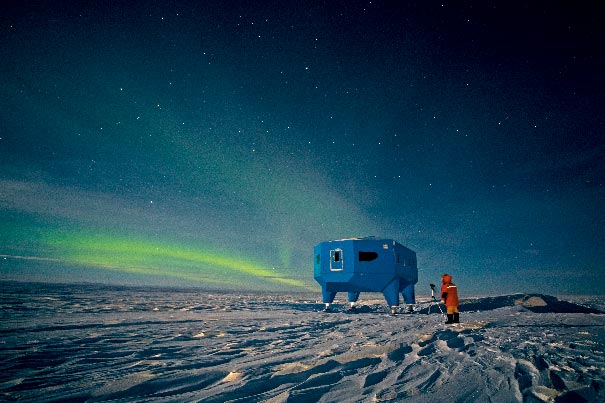
Antarctica seems so unwelcoming that it has awakened the imagination of scientists and adventurers. One hundred years ago, it was almost impossible to live there, but today the endless ice deserts of the continent have been tamed. People live there all year round, and a new generation of research stations has emerged. Their findings will help us save energy and survive extreme climatic conditions. By Henrik Bendix
There are two seasons in Antarctica: a short, bright summer and a long, dark, bitterly cold winter. In most of the continent, scientists can enjoy the midnight sun for three to four months. The majority of the people who work here, at the end of the world, go back home when winter sets in with its depressing darkness and miserable cold weather.
More than 60 stations are scattered throughout Antarctica, most of them are located near the coast and only manned during the Antarctic summer, from November to February or March. Few are wintering stations, and those are located in the central Antarctic Plateau, where the ice rises three or four kilometres above sea level.
In this giant ice desert, the weather conditions are extreme. During winter, the temperature goes below -80 degrees; that is 60 degrees colder than in the summer. A constant ice-cold wind blows, and the air is dry and thin, making it difficult to breathe. No living organism can endure such harsh conditions, not even microbes. But humans do not give up so easily.
In the winter, the permanently manned stations are left in the hands of a small group of tough scientists, who make sure each research project makes steady progress.
For eight months, the staffs are left to themselves, as during the winter the sea ice prevents ships from approaching the coast; when temperatures go below -50 degrees, planes can’t land. It is still possible to communicate with the outside world via satellite Internet connections — at least for a couple of hours a day, when the satellite is in the right position. It is a rather slow connection that is also used to transfer scientific data.
The constant darkness affects the circadian rhythm, disrupting the biological processes of the body. To minimise the risk of winter depression, the researchers have to use full spectrum lighting systems and they are advised to spend as much time as possible in the common areas, where they can engage in lively conversations with their colleagues or play table games. Those who spend the winter in Antarctica are subjected to different psychological tests to make sure they are able to endure the isolation.
If unprepared, a person will not survive for long in Antarctica, and that goes for the buildings as well. It was only during the past decade that architects found long-lasting building materials and structures for the continent.
In the past, the stations were built with massive steel tubes that were quickly covered by the snow. The staff used to live in darkness and had to dig a tunnel leading out into the open. The stations could endure the pressure of snow accumulation for 10 years and then had to be abandoned. Today, the stations are simply built on steel hydraulic leg systems that can lift the entire structure.
The new stations have round corners and smooth surfaces, and they have an aerodynamic profile that adjusts to the predominant wind direction. Consequently, the ice-cold wind will skirt around the building and gain extra speed under it, making it more difficult for the snow to settle there. Outside the Antarctic Plateau, there are rock shelves where the snow accumulates at the bottom instead of at the peak.
The architectural challenges are different in the ice shelf, where a thick layer of ice and snow protrudes from the mainland and far out into the sea. This floating glacier will keep drifting, and finally, it will calve icebergs, making it necessary to tear down the base at some point or move it on skis.
Fuel and other supplies arrive at the coast and are carried by sledge to central Antarctica. Crawler tractors pull the sledges. Some stations are located more than 1,000 kilometres away from the coast, and it takes up to 12 days to get there. On the way back, the convoy will take all debris accumulated during the winter. Nothing is left on the ice.
Typically, a number of different research projects are carried out at the same time at an Antarctic station. The continent is of great interest to climate researchers, as the consequences of global warming will show first here. At the same time, ice core drilling makes it possible to map out the climate developments of the past thousands of years.
Only in Antarctica can astronomers hunt meteorites, as they are easy to spot in the snow. And from the Antarctic Plateau, telescopes have a fantastic view of the night sky. Moreover, it is the most favourable place to examine Sun particles.
Geological surveys can help uncover Earth’s geological past, and at the coasts, biologists and palaeontologists still have some work to do. Some researchers are willing to leave the stations and venture into the ice; they sleep in tents, just like in the Heroic Era (end of the 19th century to the 1920s).
Antarctica has the clues to our past, present and future. Every year hundreds of scientists defy the cold and take up residence there. But today, a great number of new stations are waiting for them to arrive.
Some of the research stations in the area are:
Halley Station
The British were mortified: their stations in Antarctica were crushed by 120 centimetre of snow. But they have devised a new plan. The sixth generation of Halley stations was designed to last forever; it has eight individual modules that can be moved around on the ice and raised over the growing drifts of snow. The aerodynamic modules of Halley VI look peculiar, but their shape helps minimise snow accumulation. The seven 152 square metre modules (blue) contain sleeping, support, energy generation and science facilities; the red 467 square-metre two-storey module has a living area, kitchen, dining room and gym. The eight modules form a train-like structure that can house 52 individuals in the summer and 16 in the winter, when it is dark 24/7 for 105 days in a row and temperatures descend to -55°C.The modules are sitting on hydraulic legs mounted on skis, and one or two bulldozers can tow each module. The British have resided in this area since 1956; and a team of Halley scientists discovered the hole in the ozone layer in 1985. The researchers are here to make meteorological and atmospheric experiments.
Concordia station
The French-Italian Concordia station is located at Dome C in the Antarctic Plateau, the world’s biggest desert, devoid of animals and plants. In July 2010, a temperature of -83.9°C was measured here, and in the summer, the temperature is rarely above -25°C. The staff lives and works in two 18-sided buildings with 16-centimetre thick walls. The barrel shape helps minimise heat loss. One building contains sleeping, research and hospital facilities, while the other features a gym and a common room where the staff members can watch a movie or play snooker. The buildings have a diameter of 18.5 metres, a height of 12 metres and they sit on six 3.5-metre tall hydraulic legs. Concordia research focuses on how cold and isolation affect the human body — this is of special interest to the European Space Agency. Concordia also measures seismic activity, and the scientists are part of a global team monitoring Earth’s interior.
Princess Elisabeth Antarctica
Princess Elisabeth Antarctica is the first station entirely powered by renewable energy. Nine wind turbines and 380 square metres of solar cells generate electricity, while 22 square metres of solar panels heat the water. But the solar energy is only available during summer (November to February), the period in which the station is manned. Out of the 120 days of summer, there is daylight around the clock in only 100. The aerodynamic design of Princess Elisabeth, its windows, the outside plating and the insulation were carefully planned and designed. A sophisticated ventilation system helps maintain a comfortable indoor temperature without using too much energy. Every activity is monitored by a computer system that works 24/7, even when the station is deserted. The researchers are working on a wide range of projects, from astronomy to biology. In January the SAMBA team collected 218 meteorites that will help us better understand how planets formed and evolved. Other scientists are surveying microorganisms that thrive in extreme climatic conditions; and a team of glaciologists is monitoring how the ice shelf is calving icebergs — their findings will help us predict the consequences of global warming.
This feature was published in our November/December 2011 issue. To get a copy click here.






